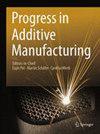三维模拟了ni基高温合金CMSX-4的凝固过程
IF 5.4
Q2 ENGINEERING, MANUFACTURING
引用次数: 0
摘要
在这项工作中,我们提出了直接耦合到热力学和动力学数据库的三维相场(PF)模拟。直接耦合允许考虑CMSX-4高温合金在大温度范围内的全合金复杂性。选择了电子束熔化增材制造的仿真条件。考虑了枝晶间液体向共晶$$\gamma '$$ γ′的转变。模拟结果证实了各合金元素具有独特的偏析行为。结果表明,处理合金成分的全部复杂性优于所有准二元或三元近似的近似,并证明了显著增加的计算工作量。我们的结果表明,多组分模拟必须成为相场应用于实际材料系统的标准。本文章由计算机程序翻译,如有差异,请以英文原文为准。
Solidification of the Ni-based superalloy CMSX-4 simulated with full complexity in 3-dimensions
Abstract In this work, we present phase-field (PF) simulations directly coupled to thermodynamic and kinetic databases in three dimensions. The direct coupling allows consideration of the full alloy complexity of the CMSX-4 superalloy over a large range of temperatures. The simulation conditions are chosen for additive manufacturing utilizing Electron Beam Melting (EBM). Transformation of interdendritic liquid into eutectic $$\gamma '$$ γ ′ is considered. The simulation results confirm the unique segregation behavior of all the alloying elements. It is demonstrated that the treatment of the full complexity of alloy composition is superior to all approximations with quasi-binary or -ternary approximation and justifies the significantly increased computational effort. Our results demonstrate that multi-component simulations must become a standard for phase-field applications to real material systems.
求助全文
通过发布文献求助,成功后即可免费获取论文全文。
去求助
来源期刊

Progress in Additive Manufacturing
Engineering-Industrial and Manufacturing Engineering
CiteScore
7.20
自引率
0.00%
发文量
113
期刊介绍:
Progress in Additive Manufacturing promotes highly scored scientific investigations from academia, government and industry R&D activities. The journal publishes the advances in the processing of different kinds of materials by well-established and new Additive Manufacturing (AM) technologies. Manuscripts showing the progress in the processing and development of multi-materials by hybrid additive manufacturing or by the combination of additive and subtractive manufacturing technologies are also welcome. Progress in Additive Manufacturing serves as a platform for scientists to contribute full papers as well as review articles and short communications analyzing aspects ranging from data processing (new design tools, data formats), simulation, materials (ceramic, metals, polymers, composites, biomaterials and multi-materials), microstructure development, new AM processes or combination of processes (e.g. additive and subtractive, hybrid, multi-steps), parameter and process optimization, new testing methods for AM parts and process monitoring. The journal welcomes manuscripts in several AM topics, including: • Design tools and data format • Material aspects and new developments • Multi-material and composites • Microstructure evolution of AM parts • Optimization of existing processes • Development of new techniques and processing strategies (combination subtractive and additive methods, hybrid processes) • Integration with conventional manufacturing techniques • Innovative applications of AM parts (for tooling, high temperature or high performance applications) • Process monitoring and non-destructive testing of AM parts • Speed-up strategies for AM processes • New test methods and special features of AM parts
 求助内容:
求助内容: 应助结果提醒方式:
应助结果提醒方式:


